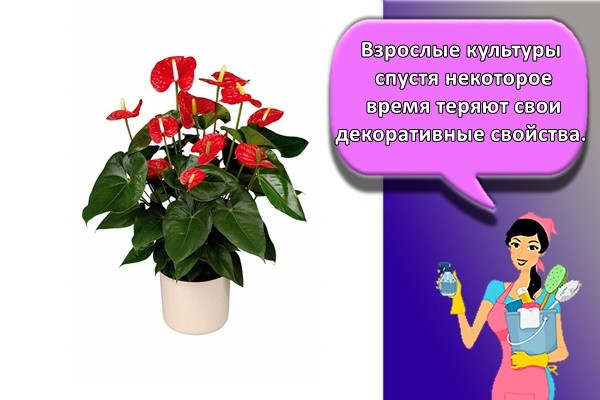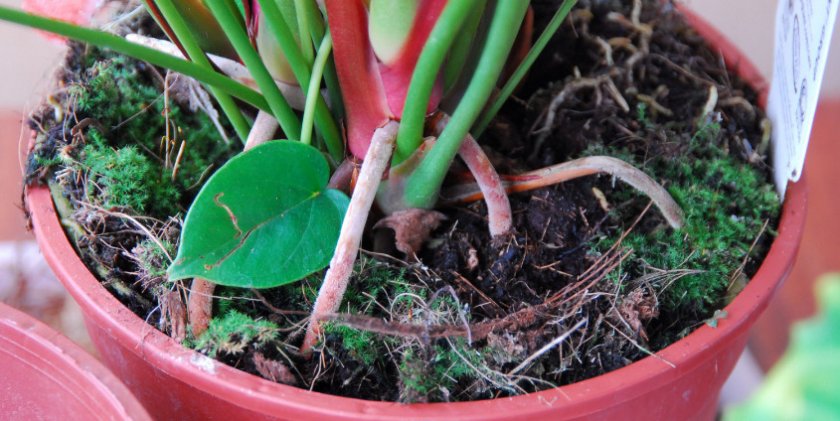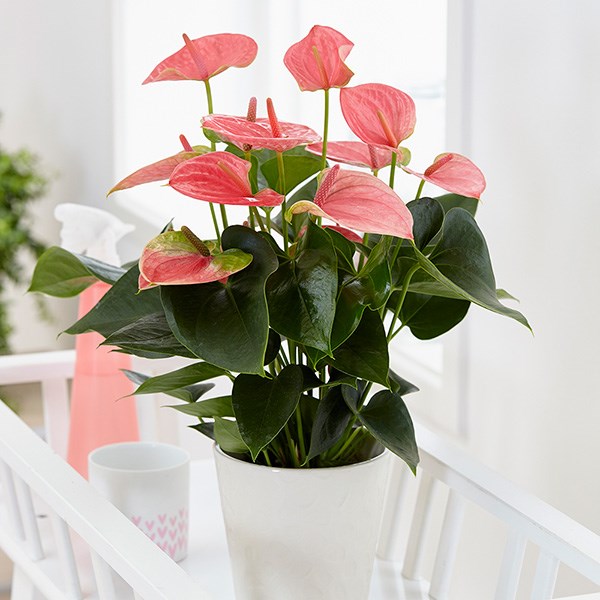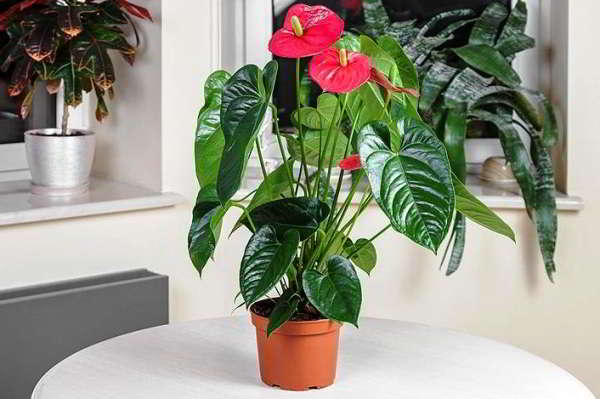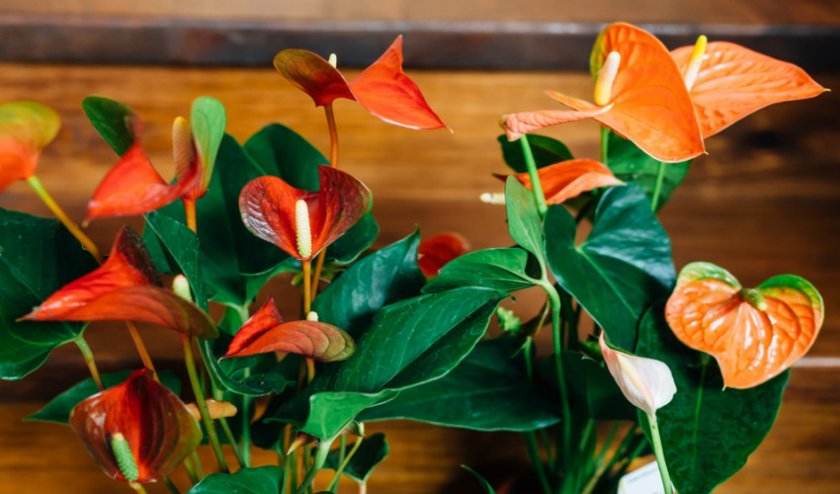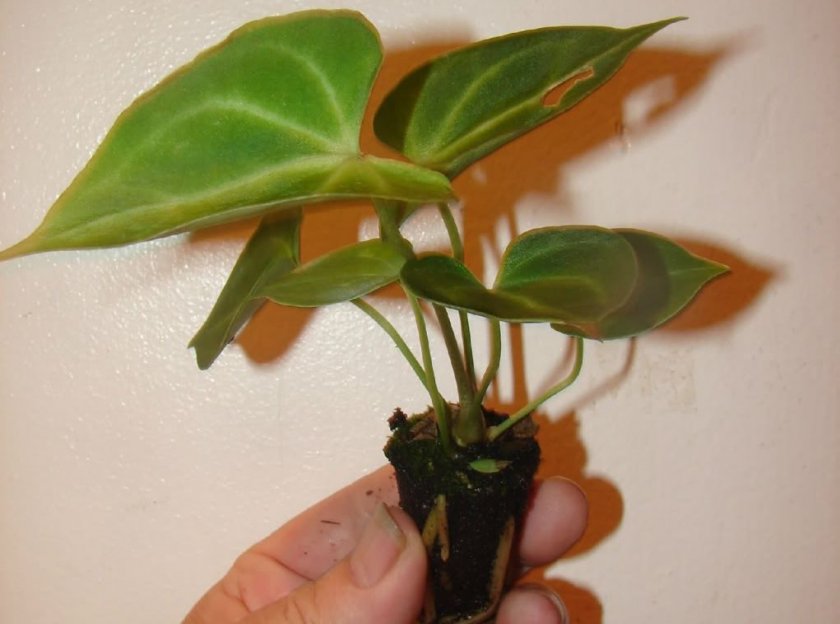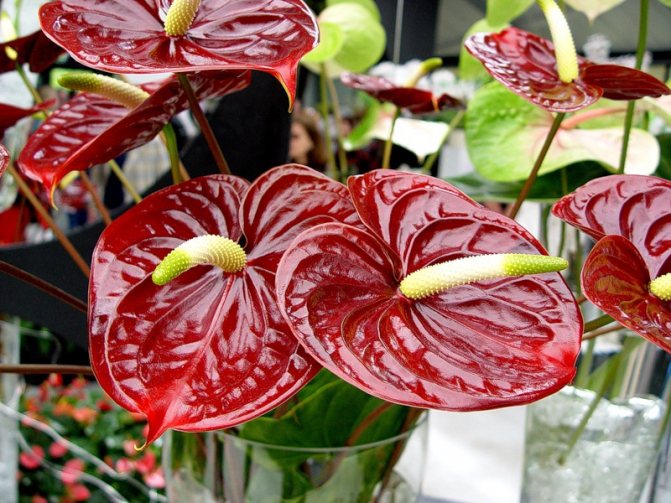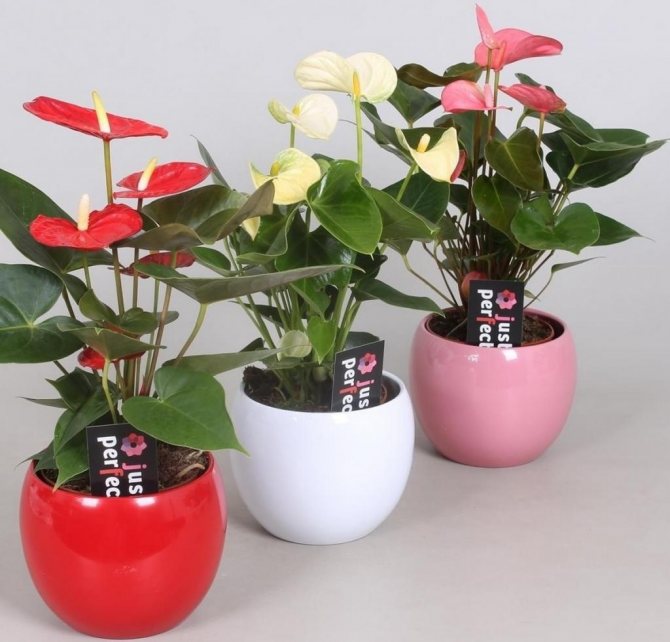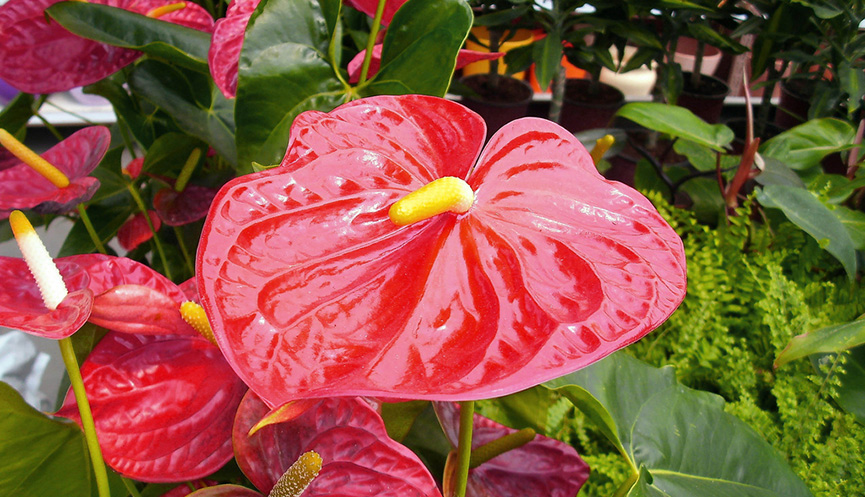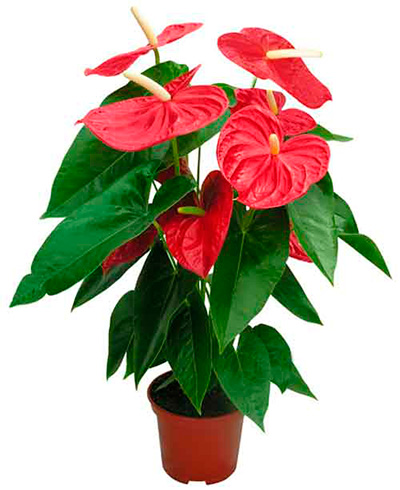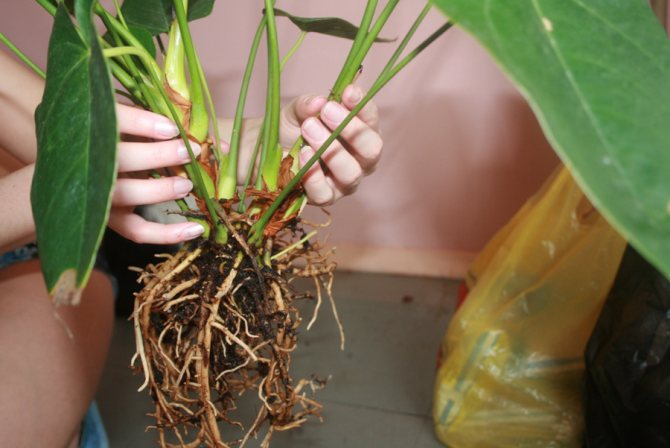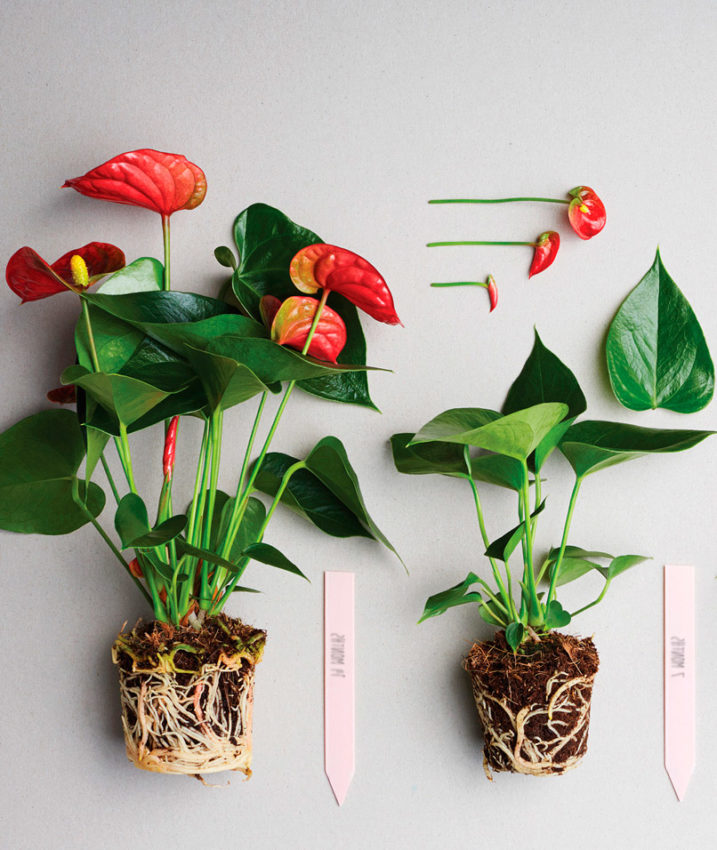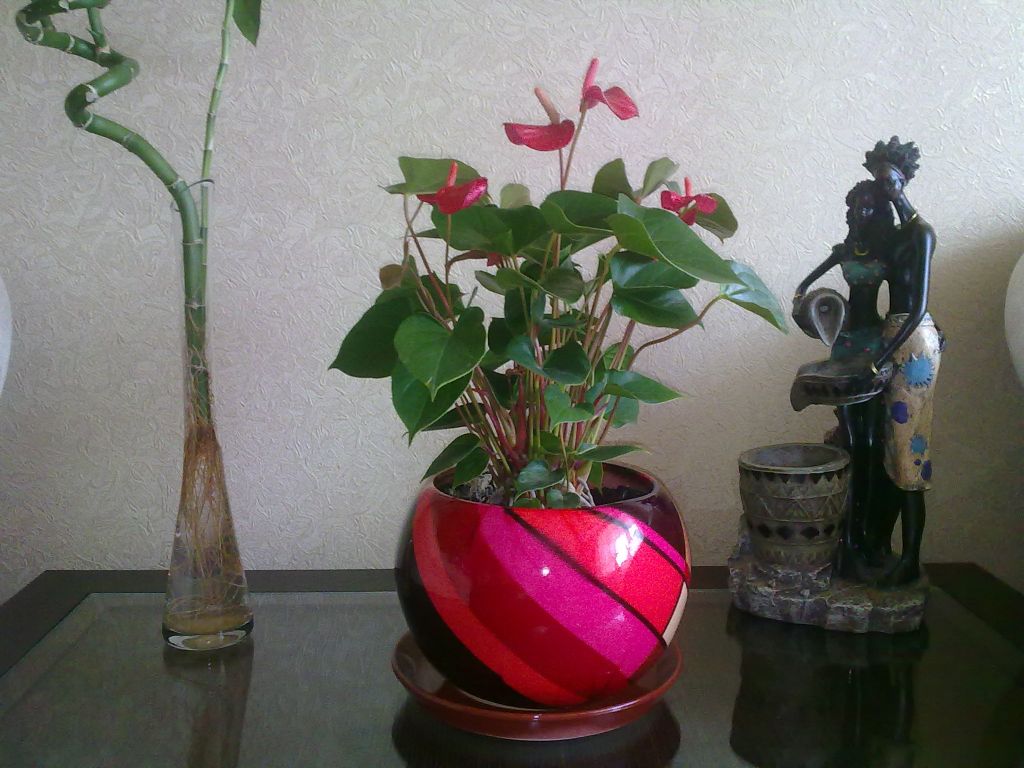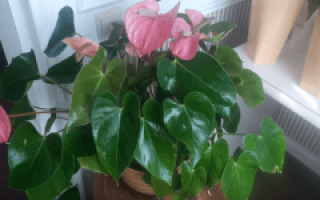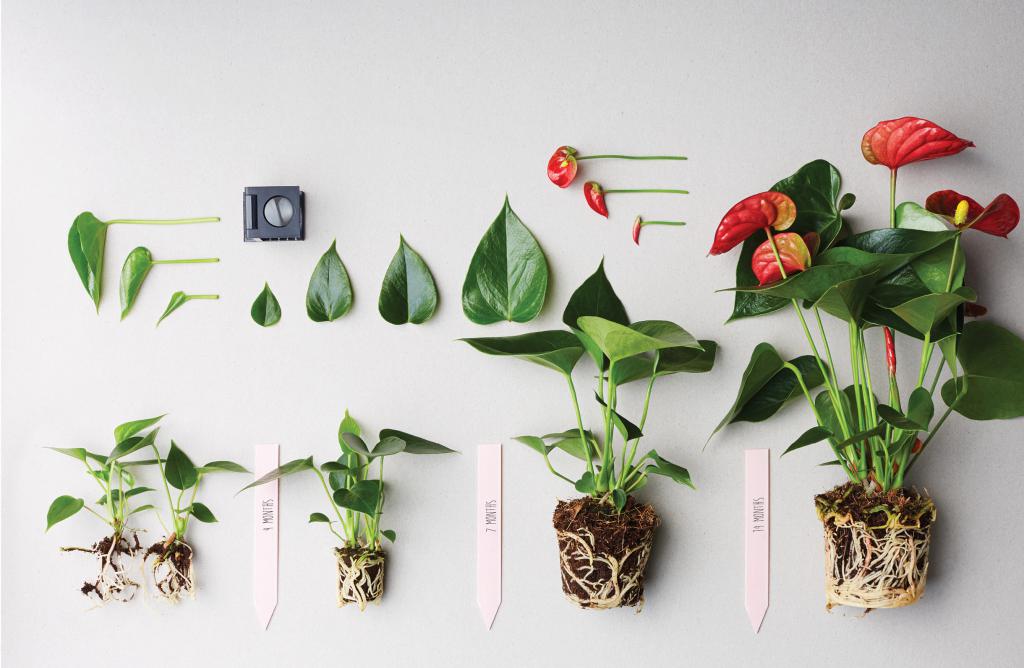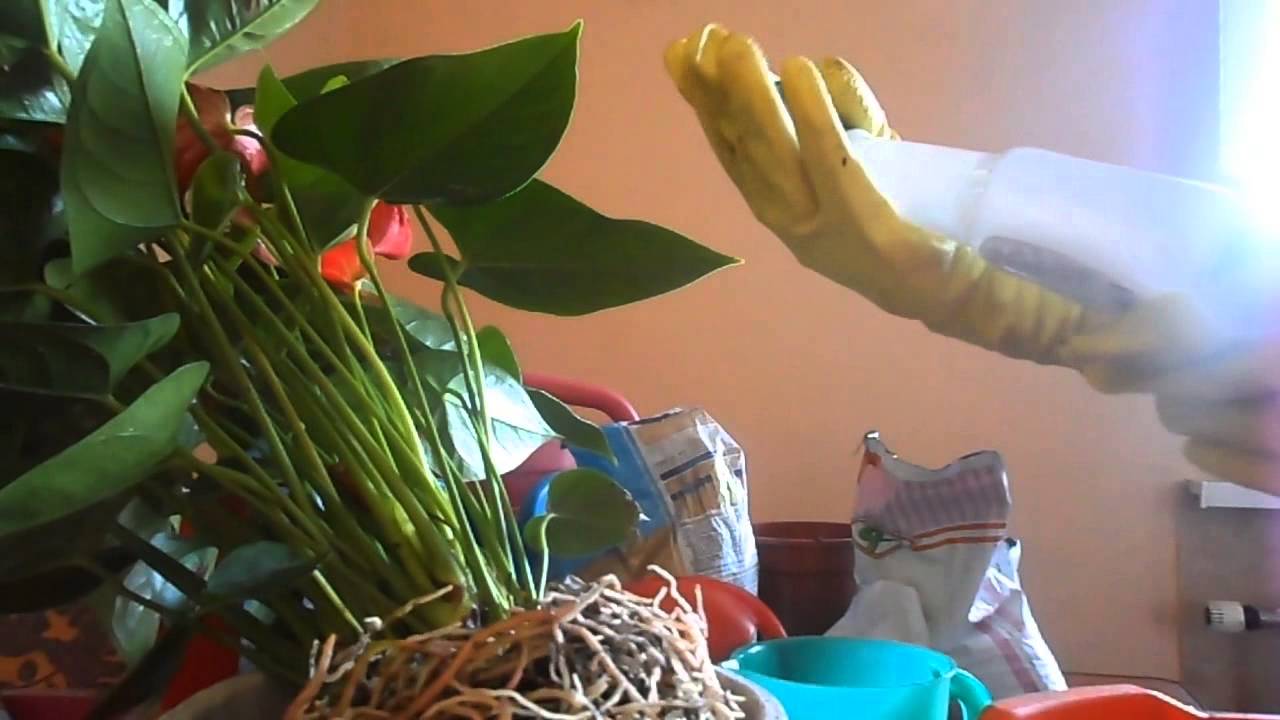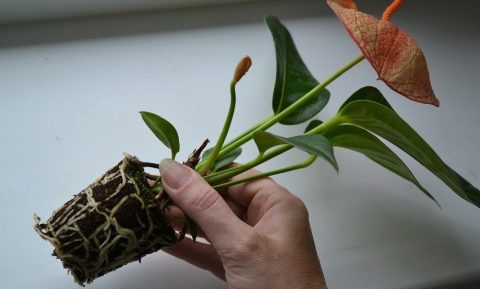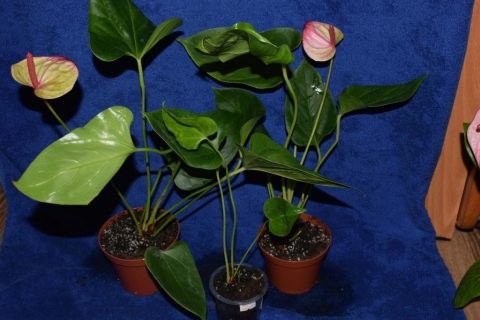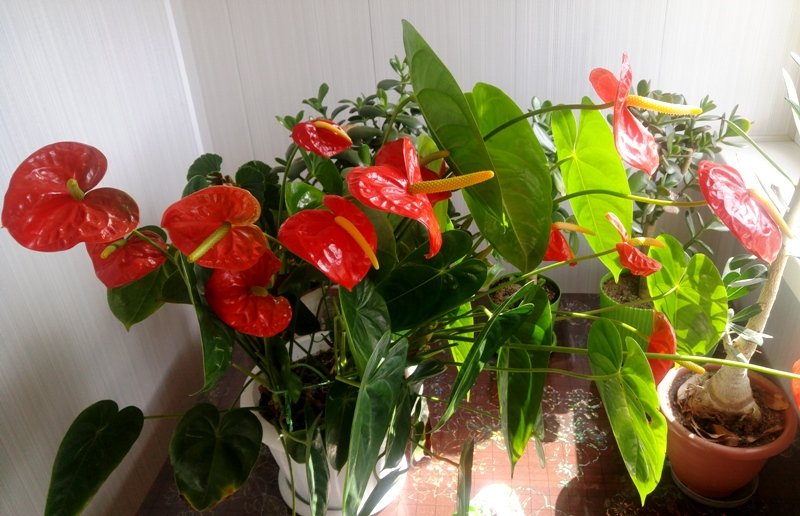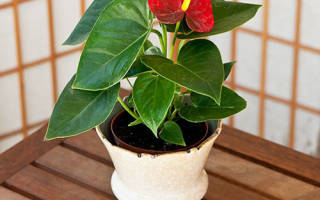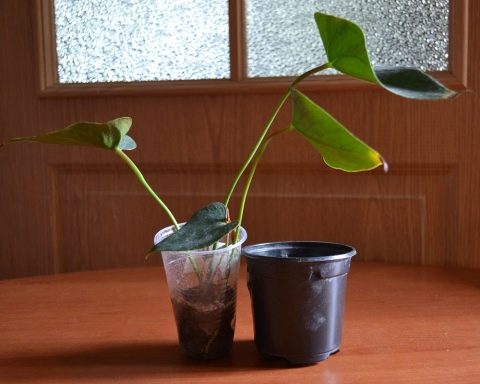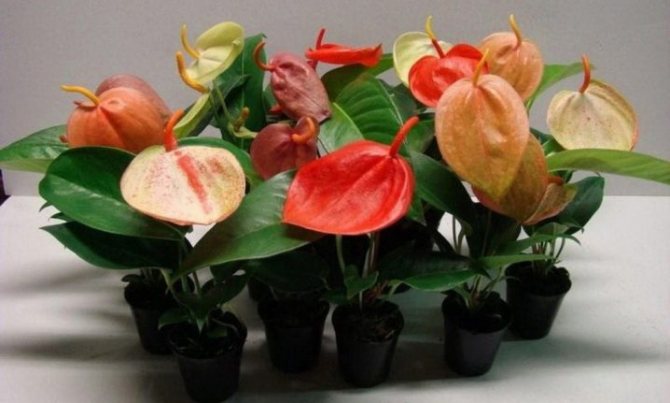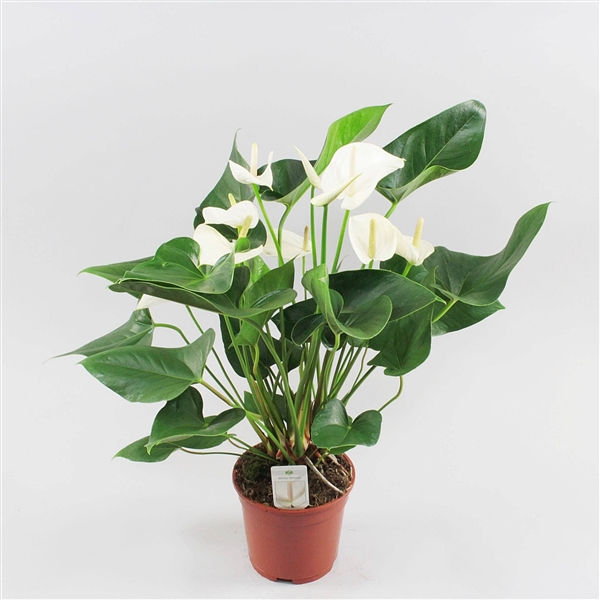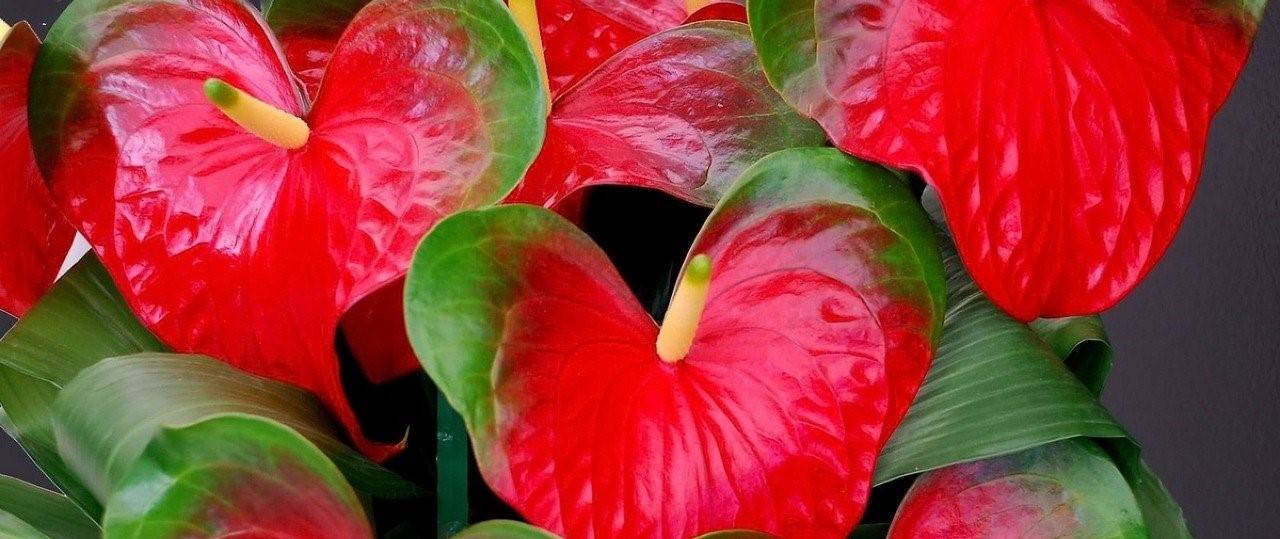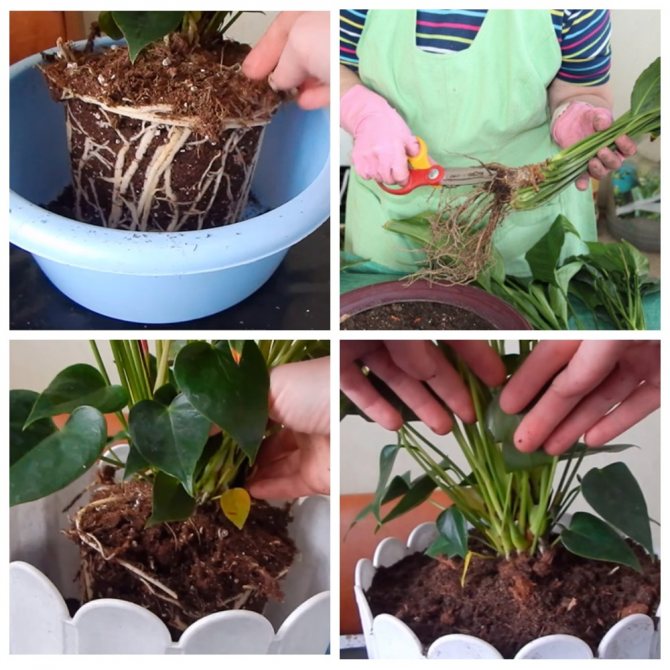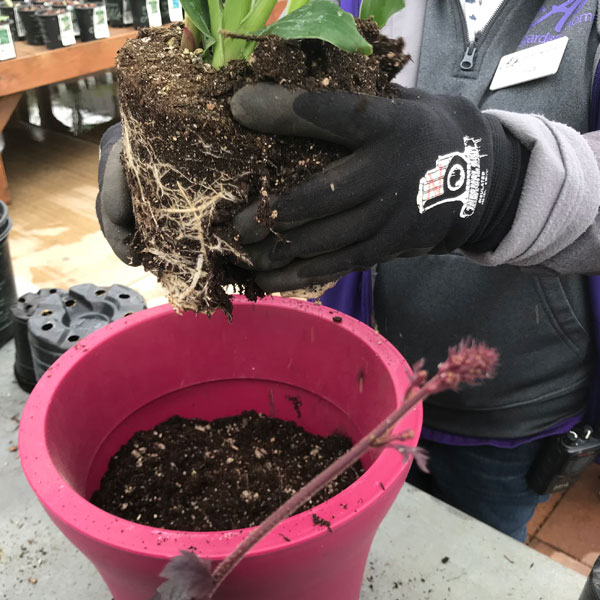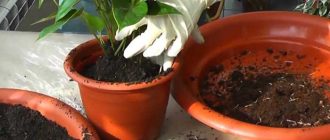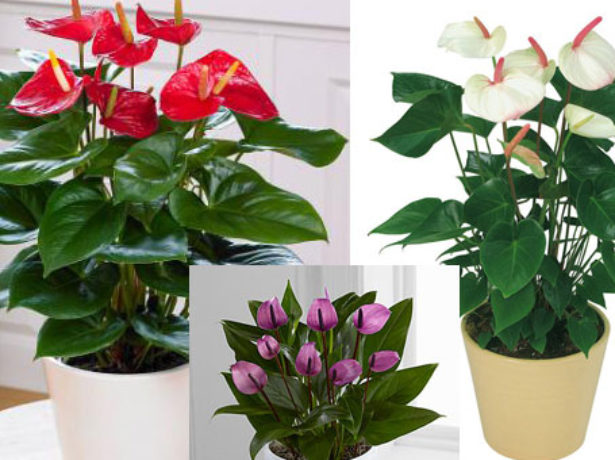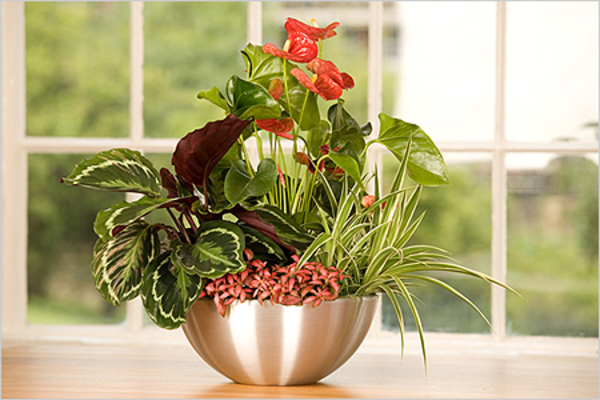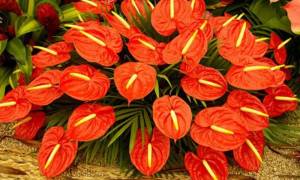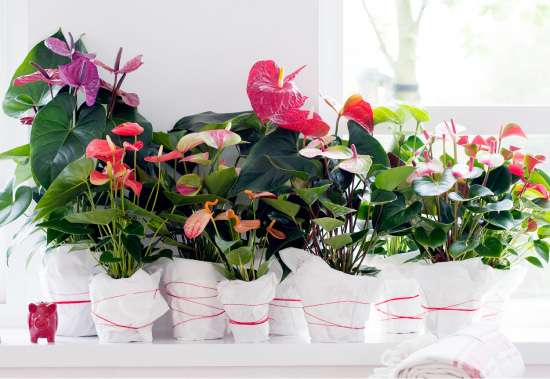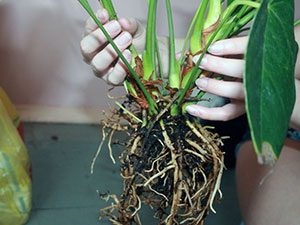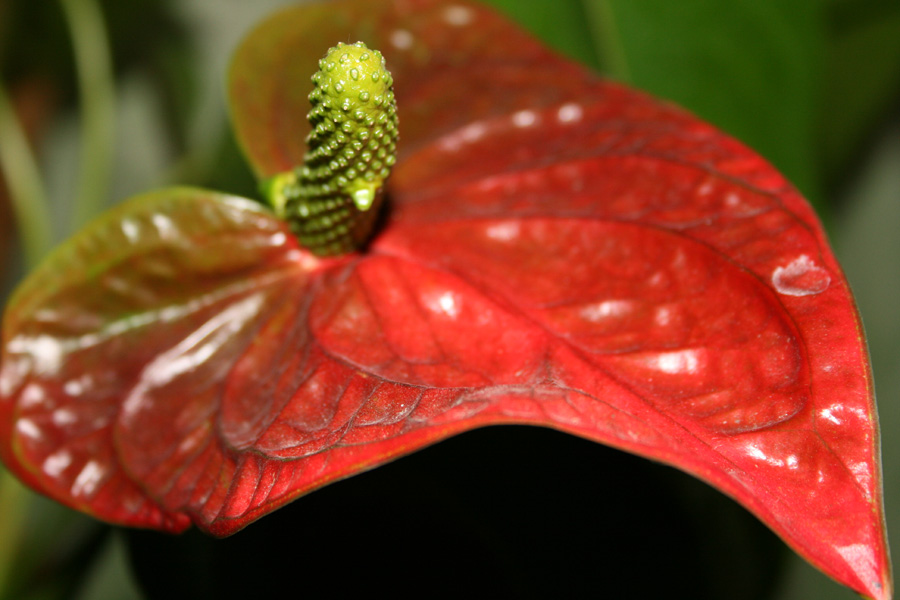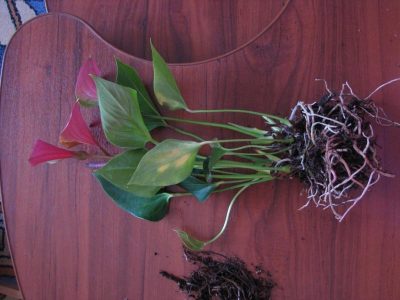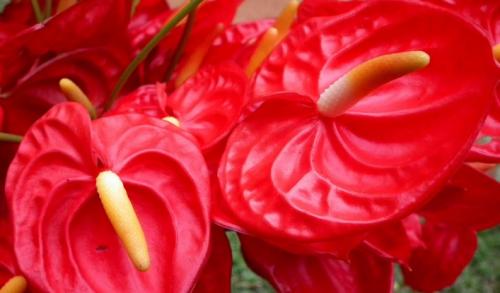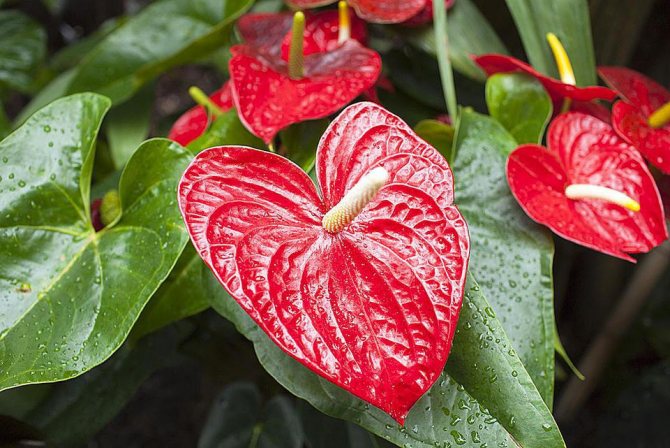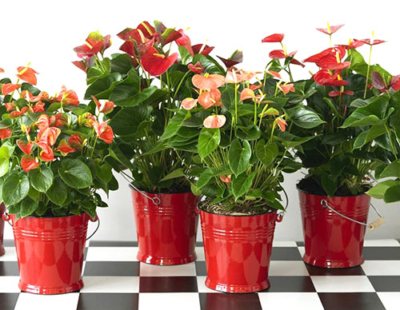Correct technology of "moving" anthurium into a new pot
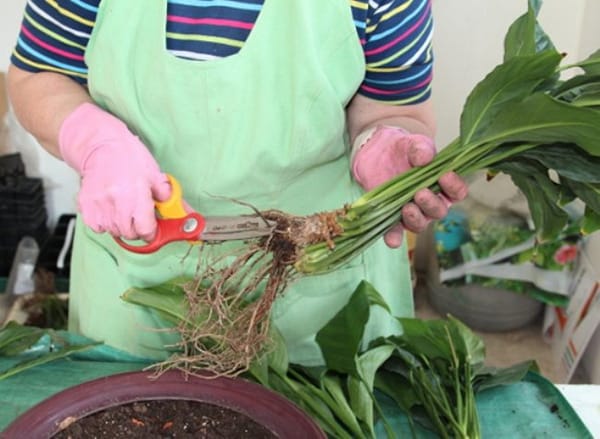
Water the flower to soften the old soil.
Remove the plant carefully from the old pot
Caution: The roots of the flower may look thick and solid, but they are actually very delicate and brittle.
Examine the root system. Cut everything spoiled (it is advisable to disinfect the tool before this by wiping it with alcohol)
Together with the rotten roots, remove the soil adhering to the roots - it probably contains a lot of putrefactive bacteria.
If the old soil is salted or there is a disease in the pot, the roots can be lightly rinsed in a bowl of water, washing out all the old soil. After that, the flower should be laid out on the table for an hour or two, allowing it to drain a little and dry out.
Even if the anthurium is healthy, you can carry out a preventive treatment of the plant. For example, spray its roots with "Fitolavin" or "Fundazol". This procedure will protect the bush from rot and bacteria. It is especially recommended to treat a newly purchased plant with such a remedy - everyone knows that in most cases both pests and dangerous diseases get into our homes from shops or nurseries!
Place the roots of the plant in a new pot filled with drainage and some soil. Add more soil around the edges, shaking the pot slightly so that it fits more tightly. You can press it down with your hands only slightly, and even then - when the plant is already completely planted. And do not fill the soil close to the edges of the pot: about 2.5 cm should remain from the soil to the edge.
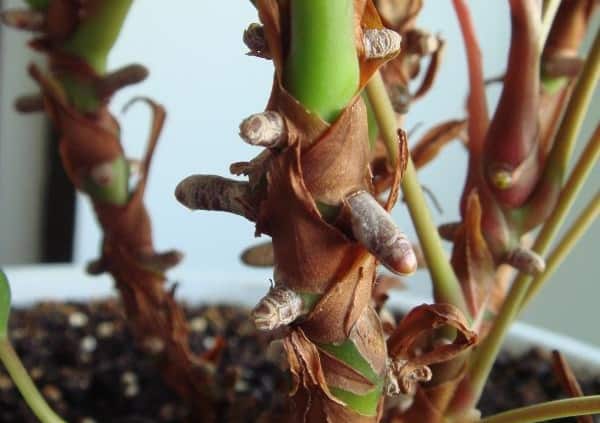
The flower has not only deep, but also aerial roots. They can be deepened into the ground, but only slightly - a couple of centimeters. And those that are higher can be covered with wet moss - such roots are afraid of drying out.
Pot selection
"House" for male happiness can be made of plastic or glass. You can also take a glazed clay pot (but the glaze should be inside, this flower culture does not fit pots with rough walls - roots can grow in them, and they will not come out during transplantation, but will break out, which will end in injury for the flower).
Personally, I'm just in awe of this pot:
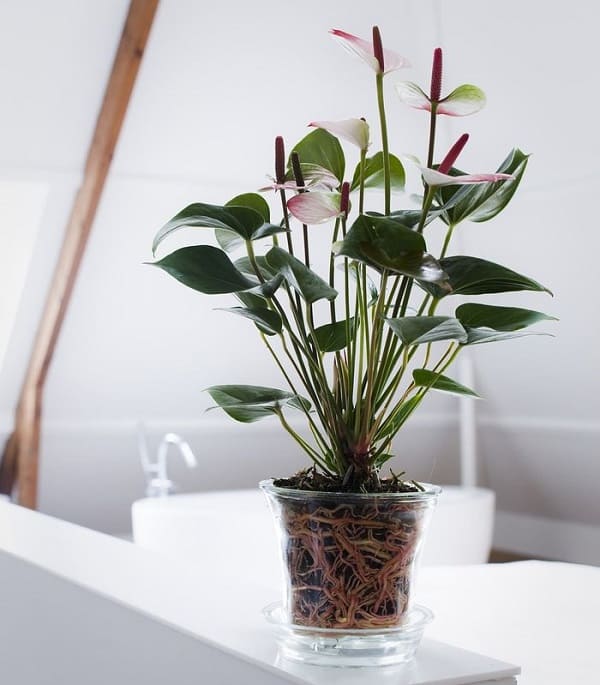
True, I bought my flower easier. Reason: drainage holes. It is very difficult to find a glass pot with holes in the bottom, and this flowerpot needs such holes - it is afraid of stagnant moisture in the ground.
The correct shape of the pot: shallow but wide.
Buying or creating a soil mixture
Since male happiness is an epiphytic plant, you can buy soil for this type of flowerpot. For example, a substrate for orchids.
Soil options you can create at home:
- small pieces of pine bark + sphagnum moss, also known as marsh moss + a little charcoal (you can also take pharmacy, activated, in tablets) + expanded clay;
- forest land + light turf soil + sphagnum moss;
- 1 share of peat + 1 share of deciduous land + 1 share of coniferous land + 0.5 share of sand + some charcoal + some bark of a pine or other coniferous tree.
When picking up soils and bark in nature, do not forget that they must be boiled or calcined in the oven. So you will protect the delicate flower from bacteria, viruses or harmful insects, the larvae of which can be in the soil and appear invisible to the unprotected eye.
Also don't forget about drainage. At the bottom of the pot (at least a quarter of its depth), you need to pour expanded clay.
Dividing a bush for reproduction
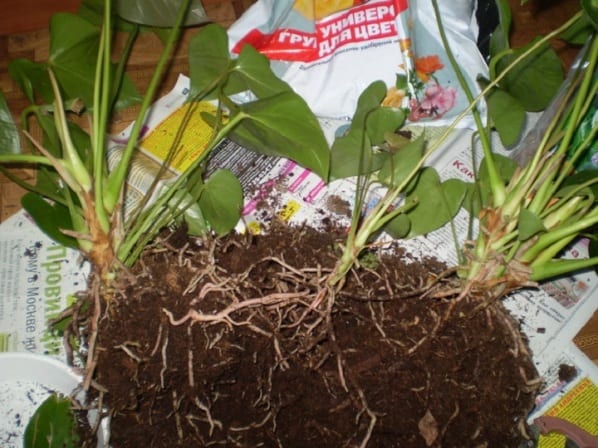
The older male happiness becomes, the thicker the bush.
The first division can be carried out in the fourth year of the flower's life.
The ideal time for such breeding is January-February. The flowerpot at this time just begins to shed old leaves, falling into a dormant period. At this time, the dividing procedure will least disturb the flower.
However, it cannot be said that in the same spring or at another time of the year it cannot be divided. Once in the summer I even divided a flowering bush, forming three flowerpots from it - and all three still bloom perfectly.
If you cannot untangle the roots with your hands, take a sharp knife and cut them in several places. But remember that this is a last resort. Never use a blunt tool (it will wrinkle the tissue, and after that the roots will only start to rot). In addition, be sure to treat the knife before the procedure by wiping it with alcohol or at least dipping it into a solution of potassium permanganate or boiling water.
Anthurium care transplant reproduction at home. Anthurium: care and transplant at home
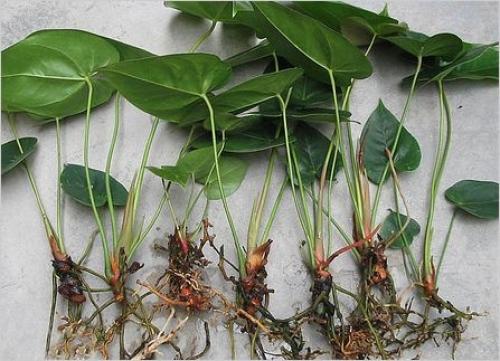
Young plants should be transplanted into larger pots each year. Adult Anthuriums are transmitted every three or four years. This should be done during the period of active growth from February to August.
Anthurium reproduces by seeds (it is extremely difficult to do this in an apartment) and by division (roots, shoots, children).
If the first method is mainly used by breeders to create new hybrids, then growers usually resort to the remaining two:
Vegetative propagation by dividing the roots occurs when Anthurium is transplanted - the rhizome is carefully separated. This way you get two separate plants, each planted in a separate pot. Before replanting, you need to moisten the soil in the pot. Then, carefully transfer the plant from the pot to a tray, shake off excess soil, and inspect it. You will clearly see which parts can be divided, as each plant will have a leaf rosette and a well-developed root system.
Propagation by cuttings is carried out by cutting off the leaf stem and immersing it in water or solution to form roots. When the plant has roots, it can be planted in a pot.
You will clearly see which parts can be divided, as each plant will have a leaf rosette and a well-developed root system.
Propagation by cuttings is carried out by cutting off the leaf stem and immersing it in water or solution to form roots. When the plant has roots, it can be planted in a pot.
Such procedures can be performed when transplanting in the spring. Large plants are divided with a sharp knife. Places of cuts are powdered with crushed coal. The separated plants are placed in separate pots. They need to be watered very carefully. With an excess of moisture, it will be very difficult for them to take root.
Preparation
Anthurium transplant can be done in two ways. In the event that the plant is healthy and the pot just became small for it, you can transplant the flower by the transshipment method. In this situation, the roots are not completely freed from the earth, but only slightly shaken off the excess substrate from them. When replanting anthurium due to disease or root rot, the root system is thoroughly cleaned of old soil and planted in fresh soil.
We select the pot
The root system of anthuriums grows in breadth. Therefore, it is better to choose a wide, shallow pot. Moisture in such a container will also stagnate less.
Important! The pot should be selected in accordance with the volume of the root system. Do not use a vessel with a reserve, the earth will acidify and acquire an unpleasant odor
If you want to get children from anthurium, it is better to take a wider pot. But in this case, the plant will bloom worse. Do you need a blooming specimen? Then transplant the anthurium into a pot 1-2 cm wider than the previous one.
It is better if the container is made of plastic, in a glass pot it is more difficult to maintain a stable temperature regime. For tropical plants, it is undesirable to expose the roots to hypothermia, this will lead to disease or decay.When planting anthurium in a previously used pot, the walls must be thoroughly rinsed and doused with boiling water or treated with a solution of potassium permanganate.
Priming
In nature, anthurium lives in dense forest thickets among fallen bark and leaves mixed with the ground. He needs about the same soil composition at home. It should be slightly acidic, good for air and moisture. If you manage to get a specialized substrate designed for growing anthuriums, that's great. In such a soil, as a rule, all proportions are observed and the plant's needs for the necessary substances are taken into account.
Some replace it with orchid substrate, which contains bark, peat and sphagnum. You can prepare the planting mixture yourself. The ground should be sufficiently loose, but at the same time keep a large specimen upright. One must definitely put a drainage. It can consist of expanded clay, brick chips or small pebbles.
The mixture should include:
- leaf humus (2 parts);
- sod land (1 part);
- coarse sand (1 part).
You can use another composition:
- sod land (2 parts);
- fibrous peat (1 part);
- pine bark (1 part);
- chopped sphagnum (1 part).
Leafy soil, bark and moss can be collected in the forest, sod can be harvested at their summer cottage. Each component serves a different purpose. Moss and pine bark make the mixture light and breathable, while leafy earth and sod provide nutrition.
Helpful advice! As a small additive, you can add perlite or vermiculite and charcoal, their share in the composition should not exceed 15%.
What if the plant does not take root or withers after transplanting?
- If the leaves of anthurium turn yellow, then most likely the root system is damaged during transplantation. This is the most vulnerable spot of this plant. If the damage was insignificant, then you just need to wait and let the flower survive the stress.
- The leaves can also turn yellow due to the difference in the composition and air permeability of the soils, if the entire earthen lump was transplanted. Only a complete soil replacement will help here.
- If the flower fades quickly, then you may have missed the pests on the roots. The plant will only be saved by a transplant with a complete replacement of the earth and the treatment of the roots with manganese. If the wilting is not very active, wait. Perhaps the anthurium simply did not have time to get used to the new conditions and it makes sense to wait for the root system to work in full force.
- Withering can be facilitated by the wrong choice of place, after transplanting. Do not forget that the plant has experienced stress; do not expose it to the sun or leave it completely without light.
- Lack of growth in the first few months shouldn't be a cause for concern. The plant simply takes up the space of the pot with its roots. If it hasn't been growing for a long time, then perhaps the pot was very large and all forces go to building up the underground part.
- The flower dries up if the watering regime and air humidity are not observed. You should study the issue of creating a comfortable environment for this plant in more detail.
Read more about the problems after anthurium transplantation here.
In order for the handsome anthurium to delight you with flowering for a long time and after transplantation, it is important to observe all stages of updating the root habitat and not neglect the importance of enhanced care during the period of anthurium getting used to a new place
Follow-up care rules
In order for the plant to grow normally and fully develop, it is recommended to provide it with comprehensive care.
Lighting
After transplanting, the bush needs a lot of soft diffused lighting. A delicate flower does not perceive well enough illumination or exposure to direct sunlight. The pot with anthurium should be placed on the east or west windowsill. With a shortage of natural light, phytolamps are used.
Temperature regime
In order for the plant to quickly recover after transplanting, it is worth maintaining a stable temperature regime. It should be +25 degrees. In winter, the temperature should be slightly reduced. Sudden fluctuations are unacceptable, as they are very dangerous for tropical plants.
Watering mode
Watering the crop is very careful. Even with careful transplanting, there is a risk of damage to the fragile roots of the plant, which increases their sensitivity to simple procedures.
After transplanting, it is worth moistening the soil quite often. But at the same time, there should be no stagnation of liquid in the pot. If water accumulates in the pan, it is recommended to drain it. The need for soil moisture is determined taking into account the condition of the soil. Watering is carried out when the substrate dries out.
Diseases and pests
The main pests of the plant are aphids and scale insects. When aphid culture is affected, the leaves turn yellow and can become covered with a sticky bloom. Their deformation is often observed. To cope with the problem, the flower should be washed with soapy water and treated with Biotlin or Akarin. When the culture is damaged by the scabbard, the surface of the leaves is covered with brown-yellow bumps. It is permissible to clean the growths with a toothbrush. It is recommended to treat the stems with a solution of kerosene.
If the leaves at the ends have acquired a black tint, this indicates a calcium deficiency. If root decay is observed, it is worth monitoring the soil moisture parameters. Anthracnose also leads to the appearance of rot. With this disease, the edges of the leaves dry out. This is a dangerous pathology that can lead to the death of a culture.

Yellowing of the leaves of the culture is often observed with a lack of lighting or due to sunburn. In such a situation, it is enough to move the flower to a new location. Excess chlorine in water is another common cause of yellowness. Therefore, only settled liquid is used for irrigation. Dry leaves appear due to sudden temperature fluctuations or exposure to drafts.
The appearance of dark spots is due to a violation of the temperature regime. They are also caused by the use of hard or cold water for irrigation. If the plant does not bloom, you can suspect a lack of light and severe temperature fluctuations. Direct sunlight on the foliage of the plant provokes the formation of burns. With a deficiency of nutrients in the composition of the soil, there is a risk of the formation of too small flowers. If the soil contains too little magnesium and iron, there is a risk of chlorosis. In such a situation, iron chelate should be used.
At high air humidity, the leaves of anthurium are covered with small drops. Such problems often occur after watering in rainy weather. Exposure to direct sunlight causes the leaves to curl into a tube.
Pollination
The need for pollination may arise when anthurium is propagated by the seed method. It should be borne in mind that this is a rather complicated and time-consuming process. For artificial pollination of a plant, you need to take a cotton pad or brush and periodically transfer pollen from one ear to the second. If there are 2-3 flowers in the room, cross-pollination can be carried out. It will help you achieve more visible results. Pollination should be performed several times within 2-3 days.
Top dressing
In the first month after moving the plant to a new place, it is not recommended to feed it. If the root system is damaged during transplantation, fertilization will only aggravate the condition. Subsequently, ready-made fertilizers should be applied to the soil. When the culture blooms, this procedure is carried out three times a month. In winter, during the rest period, the number of procedures is reduced to 2 times a month. In this case, 1 time it is worth adding fertilizer to the solution for processing the leaves of the culture.
Reproduction
It is permissible to propagate anthurium in different ways. To do this, the bush can be divided. The seed method is also often used. Side shoots, leafy or stem cuttings are often used.Each of the methods has certain features.

Breeding by dividing the culture should be done when transplanting
To do this, it is recommended to carefully separate the roots with your hands. It is not worth using a knife, as the roots break easily
Each piece must have a growing point. Thanks to this, the plant will begin to develop rapidly. With this method of reproduction, the culture will begin to bloom already this year.
The seed method is rarely used, since it is considered very laborious. At the same time, it allows you to get interesting hybrids of unexpected colors. The seeds are sold in flower shops
In this case, it is worth paying attention to the date. The fact is that the germination of anthurium seeds lasts only 3 months.
Collecting seeds from your plant requires artificial pollination. If the flowers are of the same variety, the seeds will retain varietal purity. If there are more than one plant species, you can cross-breed and develop other varieties.
To do this, during flowering, you need to collect pollen from one variety and put it in the refrigerator. When mature stigmas appear on another plant, pollination can be performed. It is carried out with a soft brush. The manipulation is performed on a sunny morning. It should be done for 4-5 days. To pollinate the cob with its own pollen, you need to take a soft brush and hold it from the bottom up, and then in the opposite direction. This procedure should be performed several times within 5 days.
In a month, the ovaries will begin to develop rapidly and the cob will become thicker. It is recommended to wait 9-12 months for the seeds to fully ripen. The ear will change color, and some berries will begin to fall out of it. The ripe fruit should be removed, peeled and the berries containing the seeds should be pulled out. It is recommended to leave them to dry for 2-3 days, and then immediately plant them in the ground. A flat container is suitable for this. It is recommended to fill it with soil, sprinkle seeds, and place another 2-3 millimeters of earth on top.
To moisten the plantings, it is worth using a spray bottle. To germinate the seeds, it is recommended to put the pot in a warm place and cover it up. The seeds will germinate in 1 to 2 weeks. A month later, we should expect the formation of the first leaf. At this time, the shelter can be removed. When 3 leaves appear, it is recommended to transplant anthurium seedlings into glasses or a box. To prepare the soil, it is worth mixing in equal parts sheet earth, charcoal and peat.
Young seedlings require full care. They are recommended to be systematically sprayed and watered.
Fertilization is also important. To transplant to a permanent place, it is worth taking a pot with a diameter of 10 centimeters and filling it with drainage by a third
It is also permissible to propagate anthurium with lateral shoots. In an adult plant, lateral suckers constantly appear, which should be carefully separated during transplantation. Don't take them out of the pot. As a result, the roots will be severely damaged, which will lead to the death of the culture.
If there is no transplant in the plans, you need to get the entire lump of soil and carefully separate the shoot with a small fragment of the root. Then place the bush back and sprinkle with fresh soil

It is recommended to place the offspring in a warm, humid place and cover with a cap. Planting should certainly be sprayed and ventilated. After 1 month, the culture is moved to a new location. It is also perfectly acceptable to root the anthurium with cuttings. The stems take root very quickly. After 1 week, the first roots appear on them. When they grow up to 2-3 centimeters, the plant should be immediately moved into the ground.
To prepare the cutting, it is recommended to follow these steps:
- separate 1 leaf with a fragment of the stem - a growth point must be present on it;
- the length of the handle should be 5-8 centimeters;
- air dry the cut for a maximum of 5-10 minutes;
- remove the sheet;
- lower the stem into water;
- cover with foil and put away in a warm place.
Certain varieties of anthuriums can be propagated using a leaf. To do this, it is enough to cut off the top of the petiole 3 centimeters in size, roll it up into a tube and secure with an elastic band. Place in a pot and cover with a glass container. Spray and ventilate the greenhouse daily. After 3 weeks, a sprout will emerge from the center. It is recommended to transplant a young plant after 1 month.
Flower care after transplant
The overloaded male happiness does not need special conditions: take care of the same as before.
That is:
- the lighting in the room should be bright, but indirect (the sun's rays should scatter the curtain or trees outside the window so that they do not fall directly on the flowerpot);
- anthurium loves warmth;
- the plant cannot live without spraying or other water procedures (for example, in winter it will not refuse to grow near a humidifier);
- water the bush little by little, waiting for the soil in the pot to dry out (take water that is settled or filtered - use the same liquid for spraying);
- immediately after transplanting, do not feed the flower for 2-3 weeks - it will find everything it needs in fresh soil.
Although this exotic is not considered super problematic, sometimes a florist is faced with the difficulties of caring for this flower. What these difficulties can be and how to solve them, the video will tell:
How to care for anthurium
Most often, a person enjoys not only the flower itself, but also caring for it, because the best qualities of his nature are manifested. Anthurium is not too demanding, however, you need to know some of the intricacies of caring for it.
Lighting
Anthurium loves diffused lighting, it is impossible that direct rays fall on the leaves. Despite the fact that the plant is shade tolerant, it will not grow well in a too dark room. Therefore, the northern windows will not work for him, but the western and eastern sides will be ideal.

Temperature
In spring and summer, a temperature of 25 degrees is favorable for a flower. If it falls below 20, then the flower can get sick. But in winter, he feels great at 17 degrees. Many varieties do not like drafts and sudden changes in temperature, so it should drop smoothly. It is also desirable that the plant be kept away from radiators.
Important: In the room where the plant is located, there should be no drafts.
You may be interested in:
How to properly water an orchid Phalaenopsis at home: tips Today the variety of flowers is very large, but despite this, the phalaenopsis orchid will not leave anyone indifferent. But, ... Read more ...
Humidity
In modern apartments, almost ideal conditions are created for this flower, but it will lack moisture. Therefore, it is necessary to purchase an air humidifier, instead of it, you can put anthurium on a tray with wet sand or expanded clay. And also it is necessary to spray the air around the flower, while making sure that water does not fall on the leaves, because it will form ugly stains.

Once a week, wipe the leaves with a damp cloth. Sometimes you can put the pot in the bathroom and water it from the shower, but make sure that the water does not get on the flowers. After the procedure, you must wipe the leaves dry with a paper napkin.
Watering
It is necessary to water the anthurium abundantly, but only after the upper soil dries up. Water must be poured onto the ground and make sure that it does not fall on the plant itself. In winter, it is enough to water once a week, more often in summer. The liquid must be poured into a special container in advance so that it heats up and settles. You can soften the water by adding a little citric acid.
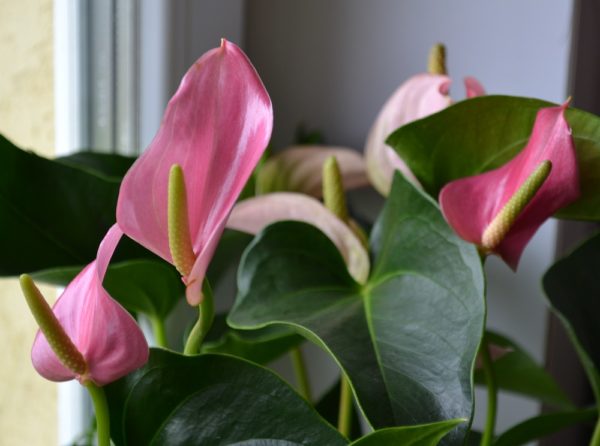
Top dressing
During the growth of anthurium and its flowering, it is necessary to feed it twice a month. For this, fertilizers are used for aroid plants, while it is necessary to reduce the dose indicated on the sachet by half.If in winter the flower is in a state of sleep, then you do not need to feed it, but only water it sometimes.
Rejuvenation
Adult crops lose their decorative properties after some time. In this case, the dying off of the lower leaves, exposing the trunk, shredding of leaves and flowers. In this situation, you need to carry out anti-aging procedures.
To do this, it is worth cutting off the top of the anthurium, which contains several internodes, and immersing it in warm water.
It is important to choose a bright and warm place. It should be borne in mind that a temperature of less than +20 degrees will cause the bush to rot
Under normal conditions, roots will appear in a short time. At this stage, the plant can be moved to the pot. If there are aerial roots on the upper shoot of the anthurium, it can be immediately planted in a prepared container filled with high-quality soil.
